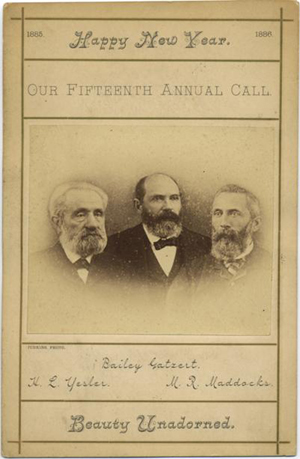A New Year’s wish from three of Seattle’s leaders, 1885
 Here is a new addition to the Washington State Library’s Special Collections: Cabinet card showing portraits of H.L. Yesler, Bailey Gatzert and M.R. Maddocks.
Here is a new addition to the Washington State Library’s Special Collections: Cabinet card showing portraits of H.L. Yesler, Bailey Gatzert and M.R. Maddocks.
Henry Leiter Yesler (b. 1810, Washington County, MD; d. 12/16/1892, Seattle, WA) established the Seattle settlement’s first steam-powered sawmill in 1852 and built the city’s first public water utility. He bought and sold a large portion of early Seattle real estate, making himself Seattle’s first millionaire in the process.
Bailey Gatzert (b. 1829, Hesse Darmstadt, Germany; d. 04/19/1893) was a partner and general manager of one of Seattle’s earliest hardware and general mercantile stores, Schwabacher Brothers and Company. He also co-founded Seattle’s first synagogue, Ohaveth Shalom, which was dedicated on September 18, 1892. Ohaveth Shalom was the second synagogue in the State of Washington, the Temple Emanu-El in Spokane being the first. It was dedicated four days earlier.
Moses Redout Maddocks (b. 11/13/1833, Bucksport, ME; d. unknown) was an owner and builder of the Occidental Hotel at Occidental and Yesler in Pioneer Square and later the proprietor of a local drugstore. He also made his wealth in real estate, much of it near the White River where he spent his summers and ran a dairy. (Bagley, History of Seattle, p.889)
All three of these gentlemen served as mayor of Seattle at some point in time: Maddocks (R) began the trend on June 5 and served until August 5 of 1873. Yesler (R) followed in July 13, 1874, succeeded by Gatzert (Ind.), who served as Seattle’s first – and to date, only – Jewish mayor, from 1875 to 1876. Yesler was re-elected to the position on July 13, 1885, and served until July 12, 1886. Gazert and Yesler were downtown neighbors in their respective mansions located on Third Avenue and James Street.
The “Beauty Unadorned” noted on this albumen print is likely referring to the fine vistas and beautiful architecture of Seattle and its environs, but perhaps these hirsute gentlemen were referring to their own handsome and rugged looks? No matter; in the spirit of the season we can forgive a little vanity.
Also notable is an interesting and timely connection to Washington libraries. The first public library in Seattle opened April 8, 1891, as a reading room on the third floor of the Seattle Hotel on the Occidental Block, site of the first Occidental Hotel that Maddocks built in 1861. The collection moved many times in the intervening years, but seven years later it found a “permanent” spot in the Yesler family mansion, staying there until it burned down in a fire during the early morning hours of Jan. 2, 1901. That day was not such an auspicious start to a New Year for Seattle. Following the fire, the library records, 2,000 volumes of the children’s titles and 5,000 titles that were circulating at the time were kept in Yesler’s old barn, which escaped cremation. The library was eventually rebuilt with funds from magnate and philanthropist Andrew Carnegie. Better to allow Seattle Public Library to chime in on this subject:
Four days (after the fire) came another shock. The Seattle Post-Intelligencer trumpeted its great scoop: Andrew Carnegie had agreed to donate $200,000 to build a new “fireproof” library in Seattle after city officials promised to buy a new library site and guaranteed an annual maintenance amount of $50,000 – such a lofty figure that the nation’s pre-eminent library philanthropist thought it was a mistake in the secret telegram from the distant Northwest. He was assured that $50,000 was “none too large” for Seattle’s needs. Carnegie responded with one of his largest library donations and his notation, “I like your pluck.”
-taken from Brief History of The Seattle Public Library, found online at the Seattle Public Library website.